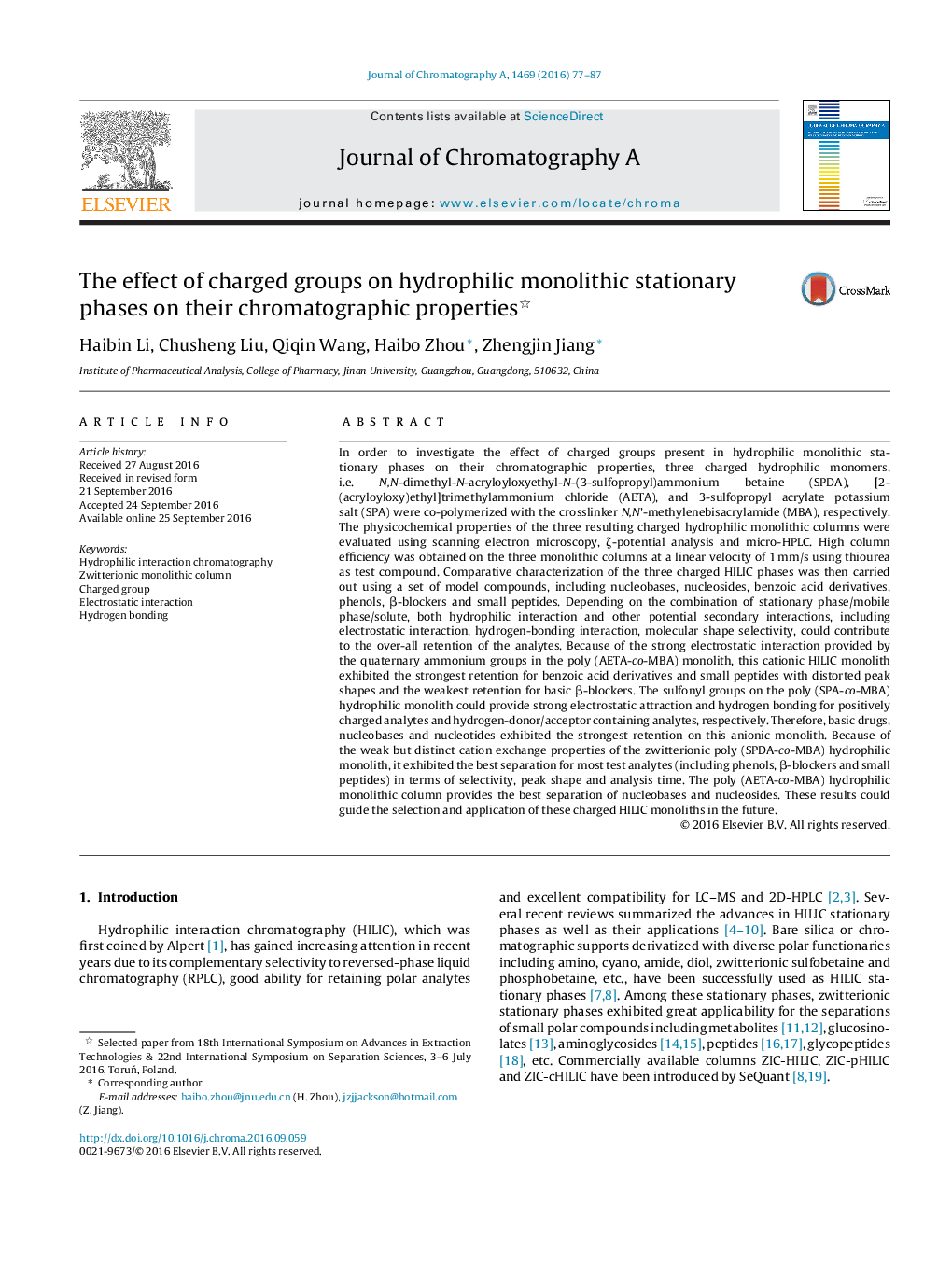| کد مقاله | کد نشریه | سال انتشار | مقاله انگلیسی | نسخه تمام متن |
|---|---|---|---|---|
| 5136056 | 1493457 | 2016 | 11 صفحه PDF | دانلود رایگان |
- Three charged HILIC monolithic columns were prepared.
- Comparative study on retention mechanisms was performed using a series of small molecules.
- Zwitterionic poly(SPDA-co-MBA) hydrophilic monolith exhibited the best separation for most test analytes.
- Hydrophilic interaction and other potential secondary interactions could contribute to the over-all retention of the analytes.
In order to investigate the effect of charged groups present in hydrophilic monolithic stationary phases on their chromatographic properties, three charged hydrophilic monomers, i.e. N,N-dimethyl-N-acryloyloxyethyl-N-(3-sulfopropyl)ammonium betaine (SPDA), [2-(acryloyloxy)ethyl]trimethylammonium chloride (AETA), and 3-sulfopropyl acrylate potassium salt (SPA) were co-polymerized with the crosslinker N,N'-methylenebisacrylamide (MBA), respectively. The physicochemical properties of the three resulting charged hydrophilic monolithic columns were evaluated using scanning electron microscopy, ζ-potential analysis and micro-HPLC. High column efficiency was obtained on the three monolithic columns at a linear velocity of 1 mm/s using thiourea as test compound. Comparative characterization of the three charged HILIC phases was then carried out using a set of model compounds, including nucleobases, nucleosides, benzoic acid derivatives, phenols, β-blockers and small peptides. Depending on the combination of stationary phase/mobile phase/solute, both hydrophilic interaction and other potential secondary interactions, including electrostatic interaction, hydrogen-bonding interaction, molecular shape selectivity, could contribute to the over-all retention of the analytes. Because of the strong electrostatic interaction provided by the quaternary ammonium groups in the poly (AETA-co-MBA) monolith, this cationic HILIC monolith exhibited the strongest retention for benzoic acid derivatives and small peptides with distorted peak shapes and the weakest retention for basic β-blockers. The sulfonyl groups on the poly (SPA-co-MBA) hydrophilic monolith could provide strong electrostatic attraction and hydrogen bonding for positively charged analytes and hydrogen-donor/acceptor containing analytes, respectively. Therefore, basic drugs, nucleobases and nucleotides exhibited the strongest retention on this anionic monolith. Because of the weak but distinct cation exchange properties of the zwitterionic poly (SPDA-co-MBA) hydrophilic monolith, it exhibited the best separation for most test analytes (including phenols, β-blockers and small peptides) in terms of selectivity, peak shape and analysis time. The poly (AETA-co-MBA) hydrophilic monolithic column provides the best separation of nucleobases and nucleosides. These results could guide the selection and application of these charged HILIC monoliths in the future.
Journal: Journal of Chromatography A - Volume 1469, 21 October 2016, Pages 77-87
